 Jennifer Krasinski
Jennifer Krasinski
Twenty-five works by the artist-writer explore the convergence of line, language, and illegibility.
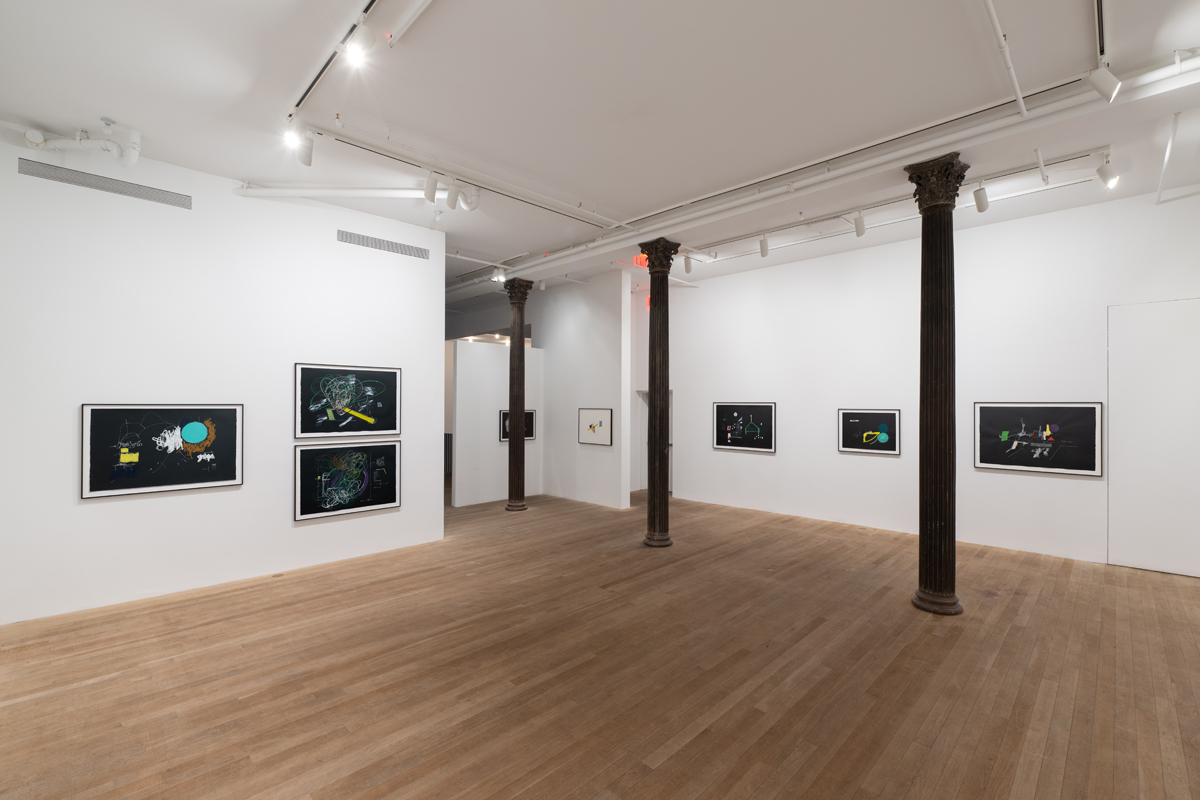
Renee Gladman: Narratives of Magnitude, installation view. Courtesy Artists Space. Photo: Filip Wolak.
Renee Gladman: Narratives of Magnitude, Artists Space, 11 Cortlandt Alley, New York City, through March 18, 2023
• • •
Let there be line. This is the first commandment for any act of creation by an artist or a writer, invoking the essential form with which all other forms will arrive, will be built. Whether sentence or pencil mark or brush stroke, all begins here. For Renee Gladman, whose marvelous show of twenty-five works on paper, Narratives of Magnitude, is currently on view at Artists Space in New York, the line has long buoyed her world-building across various practices as a poet, novelist, essayist, and artist. She started publishing her prose in the mid-’90s; she began making drawings in 2006. In an interview in 2012, she told author Lucy Ives: “If I were a really good drawer I would give up writing and just make beautiful line drawings, or at least for a while that would suffice, but I don’t draw well enough to abandon writing.”
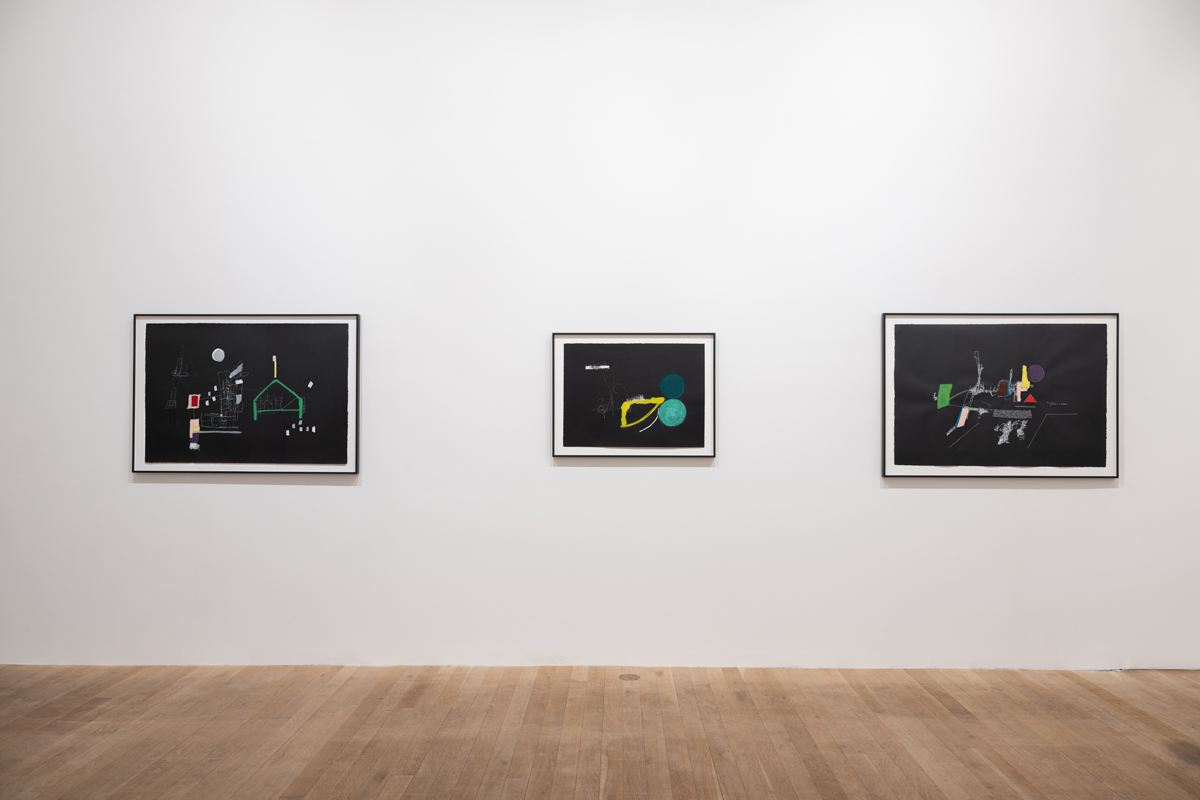
Renee Gladman: Narratives of Magnitude, installation view. Courtesy Artists Space. Photo: Filip Wolak. Pictured, far right: Untitled (black city), 2022.
It’s a lucky thing she didn’t but instead, for a time, conducted both on parallel tracks. Between 2010 and 2017, she published, among other books, an enchanting cycle of four novels that take place in and around Ravicka, an imagined city-state “large, yellow, and tender.” A book of her collected drawings, Prose Architectures, also came out in 2017, followed by One Long Black Sentence (2020), for which the great poet-scholar-theorist Fred Moten provided an index. In 2022 arrived Plans for Sentences, in which Gladman at long last paired her words and drawings, blurring the hard and fast distinctions between them. On the left-hand pages of that book are pen-and-ink renderings of what appear to be loopy, tensile cityscapes; on the right are lines of text declaring their own futures, suspending readers in the moments before action, before realization: “These sentences will keep their core lit throughout the event of this writing and will attempt to grow a floor out of an introduction then build an essay under the floor and have math be the ghosts.” Are the drawings illustrations? Are the texts captions? Yes and yes, and no and no. That’s a definitive answer, given that paradox is one of the “substrates” (to borrow a word-image from Gladman) on which she constructs room for what is possible—for what cannot be precisely articulated in language, in line: “They will form a scaffold of ascending and descending clauses and will know space / They will not know space.”
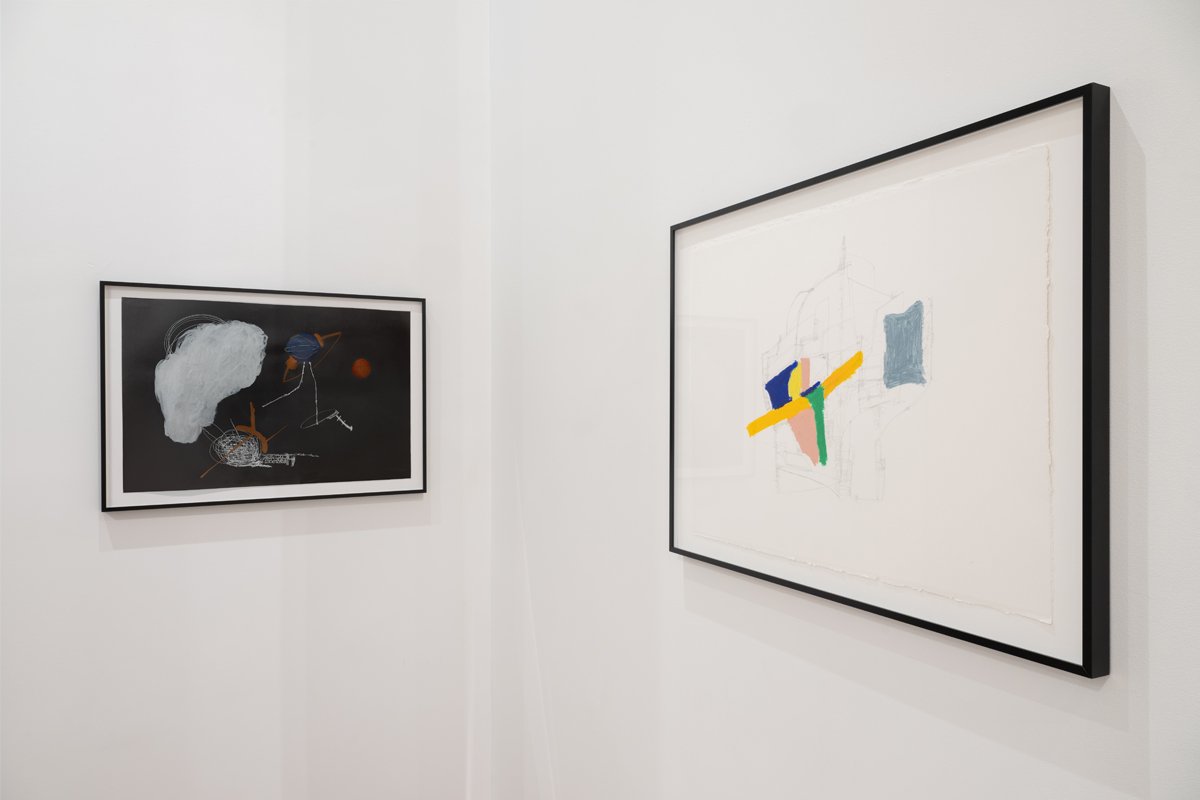
Renee Gladman: Narratives of Magnitude, installation view. Courtesy Artists Space. Photo: Filip Wolak.
The works at Artists Space, all made since 2019, are even bolder, more thrilling conflagrations that meld image and word, architecture and text, the cosmic and the grounded. Here, Gladman’s writing and drawing practices converge, becoming in most senses inextricable from one another. Their Sleep (2022), made of pigment and gouache on black paper, presents a large block of small script handwritten in white. A few redactions, obscuring select words and phrases, are also in white. What does it all say? Even nose-to-glass closeness left me none the wiser; staring at Gladman’s tiny, delicate lines—merely kinked toward language—felt a bit like seeing the forest and the trees. Perception is one subject on offer; negation, or maybe renunciation, is another.
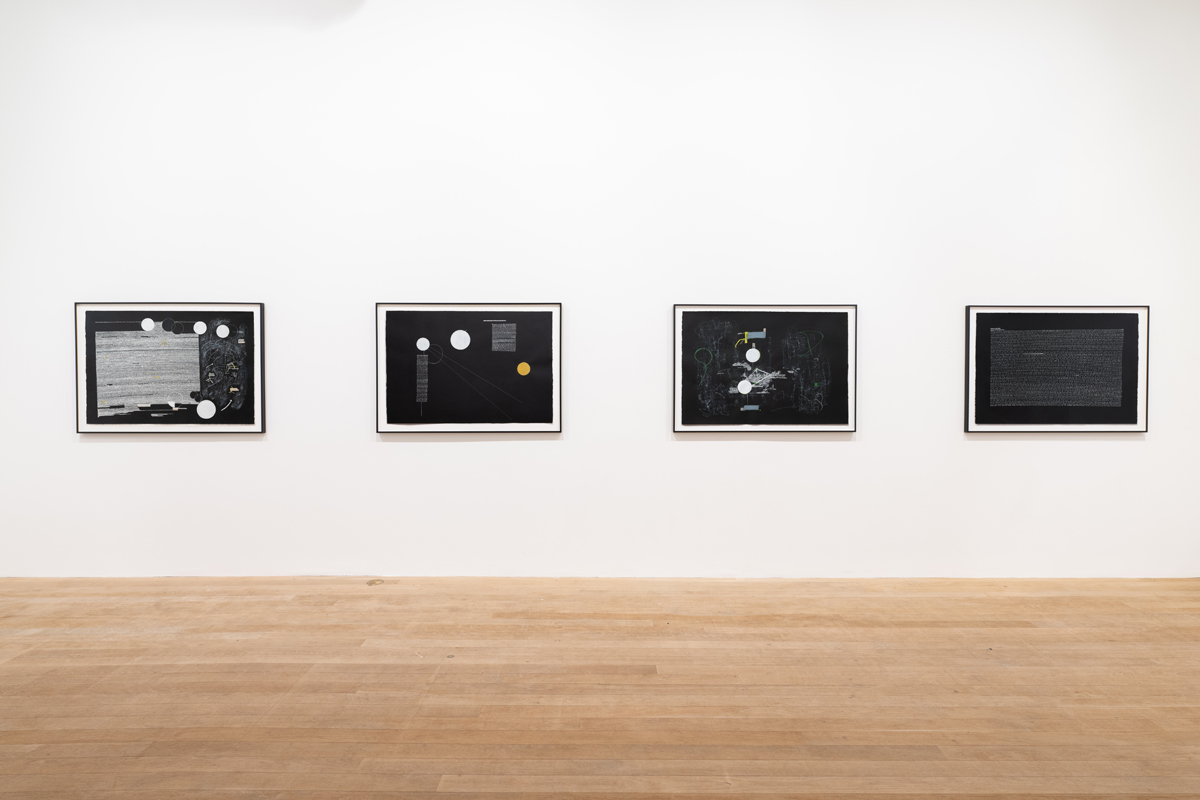
Renee Gladman: Narratives of Magnitude, installation view. Courtesy Artists Space. Photo: Filip Wolak. Pictured, far left: Untitled (moon math), 2022. Far right: Their Sleep, 2022.
Gladman deploys these texts-of-no-texts in other pieces, at times calling to mind Cy Twombly’s dynamo scribbles, or the seismographic scrawls in Henri Michaux’s classic Miserable Miracle, or the elegant graphisms of Mirtha Dermisache. Some refer to this practice as asemic, generally defined as writing that does not create meaning via language, though to understand such gestures as nonsense forecloses the possibility of discovering new sense. What would it mean to think unmoored, unencumbered by words, to write without the constraints of an alphabet? Abstraction, that old chestnut, quickly finds its way into the conversation, too, turning one’s attention to what is produced when an artist-writer picks up a pen and wields it against legibility.

Renee Gladman: Narratives of Magnitude, installation view. Courtesy Artists Space. Photo: Filip Wolak. Pictured, top right: Untitled (vector pressure fold), 2022. Bottom right: Untitled (pressure pressure infinity), 2022.
One of the show’s highlights is the dynamic, beguiling Untitled (moon math), also 2022, in which another wall of text, in white pigment on black paper, this time denser and pointedly indecipherable, takes up more than half the picture plane. The titular moons—perfect circles—hover above and lurk below, some luminous and full, painted in oil, while others are new, rendered in faint outlines. Gladman also inks curious equations into the picture, stringing numbers and letters and symbols together. Taken as a whole, the piece and all its various elements look like notes toward the unsolved, the unsolvable. That searching spirit likewise propels other works. Two installed as a pair—Untitled (vector pressure fold) and Untitled (pressure pressure infinity), both 2022—evoke experiments that have just exploded in the lab, each featuring wild knots of color amid comparatively solid lines and sober shapes.
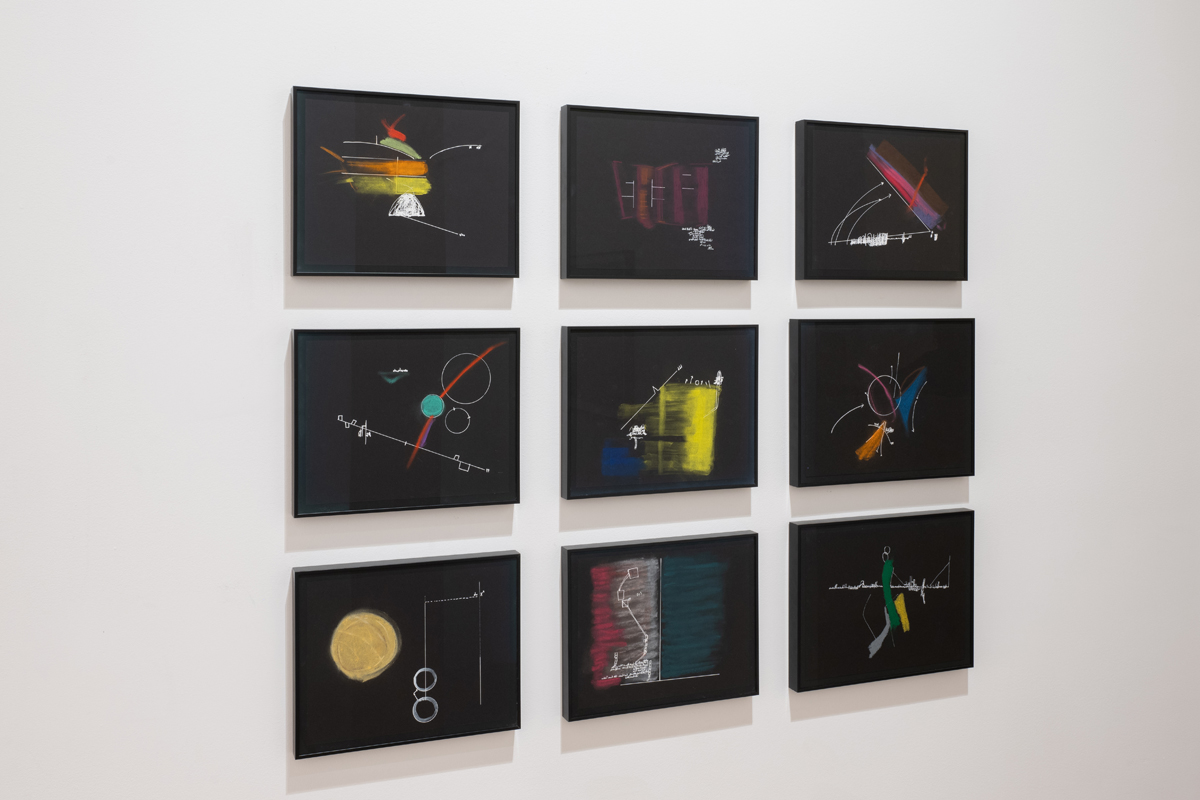
Renee Gladman, Slowly We Have the Feeling: Scores, 2019–22. Pastel and pigment on paper (grid of nine). Courtesy Artists Space. Photo: Filip Wolak.
The few drawings on white paper—as example, the lovely Grasses 2 (2022), a fantastic cityscape in graphite topped with a pendant-like composition of oil-pastel colors—manage to point out that white paper somehow only performs as itself: here is drawing as drawing has always been. Whereas in those on black paper—which spring from what Moten dubbed “the blackground: that nonrepresentational capacity that lets all representation take place”—surface is transformed into space, expansive and untethering. The images pop. Gladman’s hand, her selected hues: everything is more vivid, dazzling. Visual effect is deployed as the instrument of the visionary. Note how the dissonant structures that make up Untitled (black city) (2022) float somewhere between this world and the elsewhere in Gladman’s mind. See the sounds she’s composing for the eye in the series of nine works titled Slowly We Have the Feeling: Scores (2019–22) and recall that her hand has claimed the future as its moment in time, proposing now what could and should be.
Jennifer Krasinski is a writer and critic based in Brooklyn.